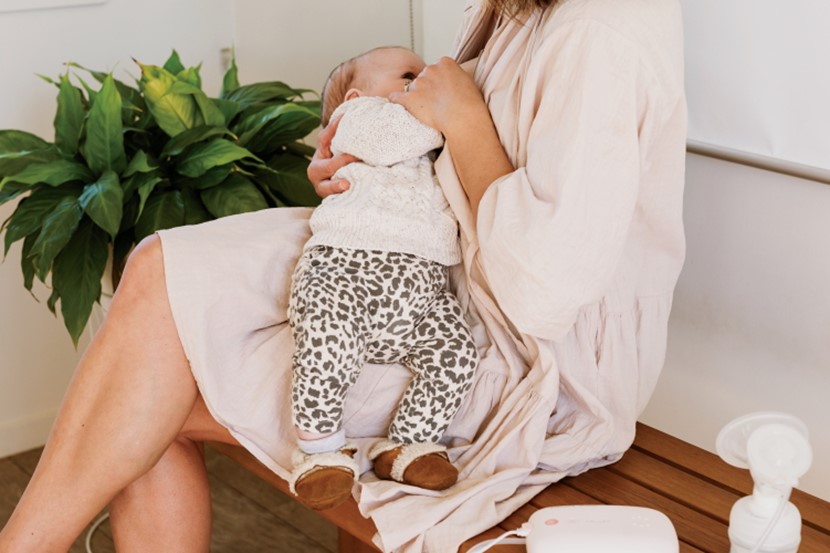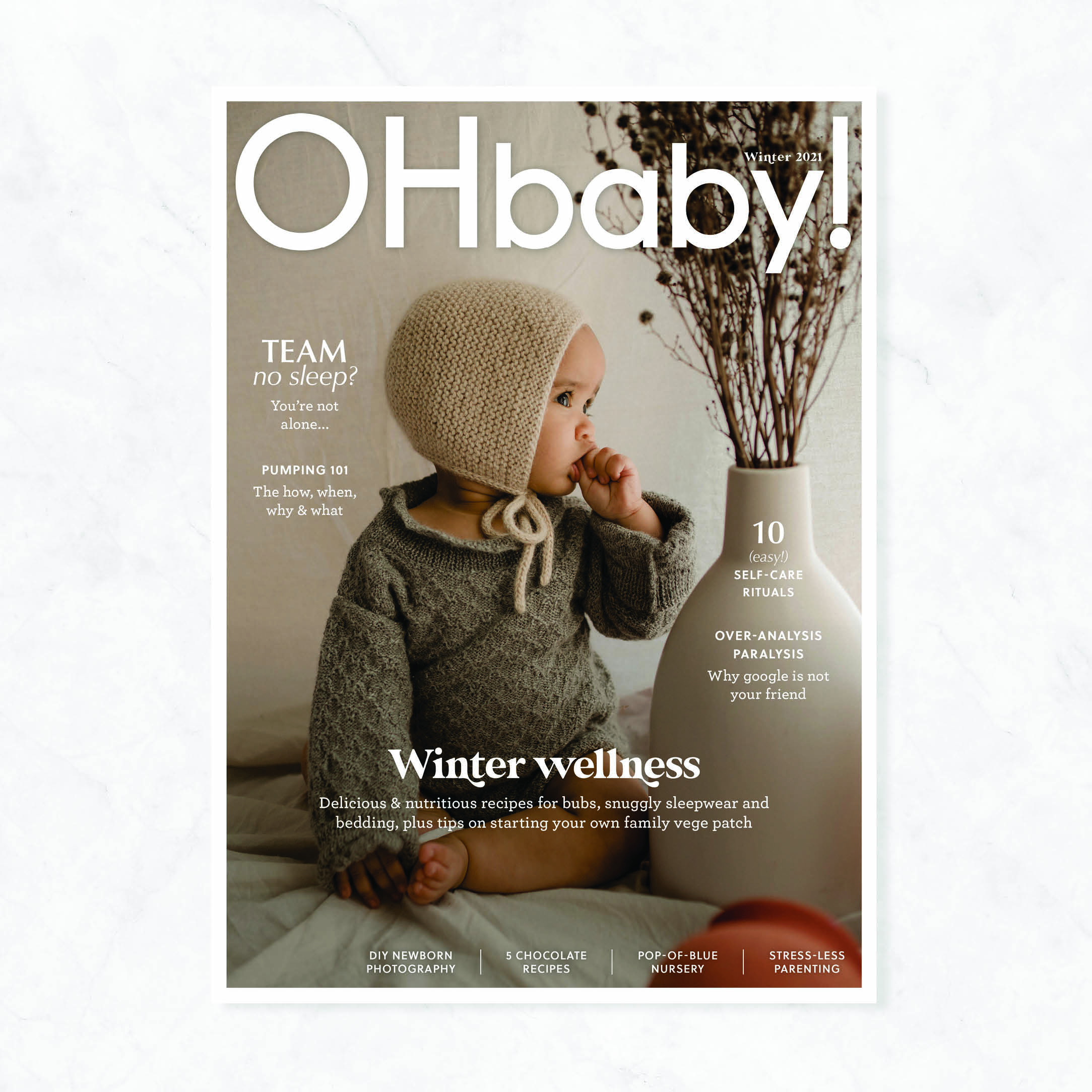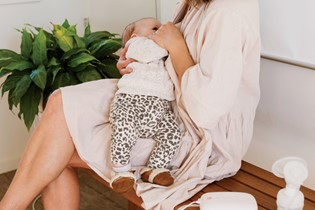Midwife & lactation consultant shares advice on how, when & why to pump

Trying to figure out whether you'll need a breast pump on your motherhood journey? Midwife and lactation consultant, Stephanie Callaghan Armstrong gives us her expert advice on how, when and why to pump.
So you’re having a baby and making a list of all the things you want and need to begin this journey. You may be wondering – do I need a breast pump and if so, which one do I choose? The answer is like everything on the parenting journey – it depends. Here are a few things to think about and some of the reasons why a breast pump may be on your baby-must-haves list.
I am certain that as long as babies have been on earth, their mothers have found ways to express their milk to feed them. Evolving technology with farming animals for milk has helped with manufacturing smaller versions for human milking – unglamorous as it may sound! Using the same concept of a vacuum that mimics a baby’s rhythmic sucking, there have been some very weird and wonderful, complicated and super uncomfortable-looking breast pumps made over the last few centuries. Today’s mothers are so lucky to have some amazingly effective (and comfortable) options to feed their babies breast milk and to stimulate and maintain their milk supply.
I never like to miss an opportunity to promote breast milk for babies as a complete and incredible first food in the first six months of life (and beyond into the second year of life with the introduction of solids, as recommended by the World Health Organisation.) The nutritional and protective properties in human milk form a list as tall as my clinic door and breastfeeding or feeding baby breast milk has been shown to provide lifelong protection for baby from many diseases and health issues. The action of breastfeeding helps strengthen both mother and baby bonding and baby’s jaw development, as well as helping to metabolise fat for mama that was protectively laid down in pregnancy.

EXPRESSING IN PREGNANCY
In the final month of pregnancy, it is becoming popular for mums to start hand expressing and storing colostrum in syringes to give to baby after birth in the event that extra is needed. It also helps a new mum learn to hand express, and may help colostrum to flow better after baby is born.
If you maybe have gestational diabetes or pre-eclampsia, are having an elective Caesarean section or there is another medical reason (such as a baby being diagnosed prenatally with a congenital condition like a cleft palate or lip), expressing before birth is a great way to be prepared.
Other reasons could include a mum having inverted nipples; previous breast surgery that could have caused damage to milk ducts or nerves that carry the milk-making message to the brain; or a known medical reason that may make latching baby difficult or cause a low milk supply. Having colostrum ready in anticipation of any difficulties gives a new mum peace of mind which is worth its weight in gold.
WHEN TO START PUMPING
It is best to only pump as necessary in the first month of baby’s life while breastfeeding and your milk supply establishes. In an ideal world, when baby is born, skin-to-skin contact directly after birth and early breastfeeding with baby latching correctly is the best way of establishing a good milk supply with baby then breastfeeding every few hours on demand. Your baby is born with a stomach only the size of a marble on day one so initially only requires a small volume of colostrum in each feed.
Pumping unnecessarily could actually create an oversupply if you're pumping amounts that are surplus to requirement. Giving baby bottles of milk with teats, or dummies to soothe, may also interfere with both latching and supply and demand. It's recommended to wait until baby is at least one month old before trying teats and if any supplement feeds are needed, you could try a supply line while baby is latched at the breast, or expressed milk from a cup, syringe or teaspoon.
Until your milk comes in, the best way to express colostrum is by hand. This is because colostrum is very dense in nutrients but usually low in volume for most new mums, and would only stick to the sides of the tubing and be difficult to collect if using a pump. Ask your midwife to show you how to hand express or to help you if you have difficulty latching baby or extra milk is required (if baby is in the special care unit, for example). If your baby is unable to latch and feed in the beginning, it's important to stimulate your milk supply by expressing. After a day or two, as the milk starts to flow, using a breast pump is the next step. If you are in hospital or a birthing unit, usually they will have hospital grade pumps and experienced staff to help you if you need to use a breast pump.
TAKING CARE
The number one obstacle to breastfeeding reported by new mums, and a common reason for giving up in the early days, is nipple pain and trauma. It is normal to experience some discomfort with a new baby frequently feeding, even if he or she is correctly latched. Rubbing on some expressed colostrum or nipple cream to encourage healing may help. It is most important to get professional support if you feel pain early on, so as to prevent ongoing trauma.
For some mums, even one feed with an incorrect latch or an anatomical issue (like a tongue tie) can cause significant damage to the mother's nipples. Bleeding, grazed and painful nipples can be unbearable to breastfeed from. In this situation, your midwife or lactation consultant may recommend you stop latching baby and use
a breast pump instead for a short period, which can be less painful and give you a chance to heal. If you are using nipple shields, expressing several times a day is important to provide good sucking stimulation as shields are known to reduce milk supply over time (they are recommended for temporary use only).
Always seek the help of your midwife or lactation consultant when you are having a tough time as they are experienced in diagnosing what's going on and supporting you to help maintain your milk supply, heal, and also treat causes of infections and trauma to get baby back feeding on the breast. Many women report feeling like they have failed if they need to remove baby for a short while to express but it can be a very good solution for desperate mums who otherwise couldn’t keep going due to the pain.
- Seek help if you have breastfeeding difficulties and are in pain.
- Get your health professional to examine your breasts and baby’s mouth to assess why trauma has occurred and to treat any yeast or bacterial infections on the nipples.
- Regular pain relief like paracetamol or Nurofen can help.
- Pump regularly with a good breast pump to maintain your milk supply and prevent breast infections. Massage away any lumps before and after expressing.
- Remember, your nipples should heal quickly as they have a good blood supply.
- Once the cause of trauma is resolved, you will hopefully have many happy, pain-free breastfeeding months with your baby ahead of you.
- If your budget is tight, I would say hold off purchasing a pump till you know you need one. If baby feeds really well with no issues you may not need one.
WHICH PUMP DO I BUY?
So you need a pump, or you’ve decided you’d like to have one at the ready should you ever need it. Which one do you get?
Many mums are given pumps by generous family and friends but ideally you should decide which one is right for you, so don’t open the packaging if you get given one as a gift – you may be able to swap it.
In my opinion, the most important features of a breast pump are good suction and comfort. Does it have a kit with different flange/cup sizes or is it one size fits all? Breasts and nipples are not at all one size of course, so a range of sizing options is a great place to start.
Check out reviews of breast pumps you’re interested in before you purchase.
Price is important. Invest as much as you can afford in a personal pump. I often see women struggling to pump their milk to feed baby and they end up needing to buy several pumps before they find one that works, amounting to a much higher cost than just originally investing in a higher quality one. However, there are some effective low-cost pumps and expressers too, so it comes down to personal preference, what you need it for, and trial and error. Hand pumps with handles are pretty labour intensive and hurt your wrist, whereas electric pumps often have batteries and car plug-ins to help you be more mobile with expressing.
Renting a hospital grade pump is also an option if you have a more serious need to express in order to establish and support your supply if baby is not breastfeeding or not feeding well. They are designed to better replicate baby’s suction than smaller pumps as they have a larger motor, are less labour intensive, and you are usually able to express more milk. (Double pumping kits are recommended as they cut down pumping time by half and it also stimulates the milk-making hormone prolactin when you express two breasts at once!)
THE LOW-DOWN ON LOW MILK SUPPLY / SLOW WEIGHT GAIN
Breast pumps can be a lifeline to help increase your milk supply. They provide extra stimulation and therefore extra milk for baby if you're struggling to produce enough, or if baby has static or slow weight gain. Sometimes a baby with extra needs (a premmie or a baby with low tone from a congenital condition) is unable to remove enough milk from your breasts and needs supplementary feeds. For low milk supply, some mothers require natural supplements like blessed thistle or fenugreek and increased dietary proteins, and sometimes medication is needed to help increase their milk supply.
It is always recommended to express with a good pump after feeds, at least a few times a day in addition to breastfeeding, if you have a low supply. Pumping sends the brain a message to make more milk.
PUMPS FOR SPECIAL CIRCUMSTANCES
Breast pumps also can be very effective in special circumstances, like inducing lactation when adopting or in the surrogacy of a baby. Pumping and hormone supplements have successfully helped mums to breastfeed their babies when they haven’t biologically carried them.
Human milk banking and giving/receiving pumped donor milk has increased in popularity around the world and it has my full support. If you google ‘donor milk’, you will find a number of sites you can either donate to (if you have too much) or receive breast milk from (if you have too little). There is a screening process to follow for donors to ensure the milk is safe. There are even donors out there who have restricted diets to provide milk for allergenic baby needs.
All babies, but especially premmies or newborns fighting infection in the early days, have been shown to benefit so much from being fed with breast milk. Some mothers may not be able to breastfeed or produce enough milk for a variety of different reasons, but really want baby to receive all the benefits of breast milk nutrition. On the flip side, some mums make ‘enough milk to feed a village’ . Maybe in your own ‘village’ there are family or friends you can share milk with?
I had an issue arise with my fourth baby, Liberty-Faith, where I ended up with a life-threatening and rare pregnancy condition and the medication I needed meant it wasn’t safe to feed her my milk. I ‘pumped and dumped’ my milk for four months and a beautiful friend of mine pumped 1-2 bottles of milk every day for Liberty-Faith so I could mix feed. When I was able to restart breastfeeding, I had maintained my supply by pumping and was able to latch her back on and breastfeed for a few years after. I will always be grateful to that generous friend Carien, and Raewyn and Abby too!
- Do your research and make sure the donor is screened for the blood tests needed to rule out infections that can be contracted through body fluids, particularly if you don’t know the donor.
- Have rigorous hygiene standards of storing and transporting donor breast milk in a chilled state.
- Remember that even one bottle a day of breast milk has a lot of benefit for a baby.
BREAST MILK STORAGE
- Breast milk is a live body fluid substance packed with antibodies and once expressed, has shown to be safe kept at room temperature for a few hours.
- Store milk in clean bottles or milk collection bags at the back of the fridge. Keeping milk in the door increases the risk of bacteria forming every time the fridge is opened.
- Frozen milk (stored at the back again) can be kept for 6 -12 months.
- Defrost in the refrigerator and warm all breast milk slowly in a bowl of warm water, so as not to kill the antibodies and nutrition.
- If the defrosted milk tastes or smells funny, don’t panic – it’s still safe to feed baby. A tip I learned recently from a lactation consultant colleague was to add a tiny drop of vanilla essence. It makes the milk smell and taste more palatable and neutralises it for baby.
CLEANING AND STERILISING
Pump parts need to be kept spotlessly clean as they have the potential to grow bacteria. For a healthy term baby, a hot soapy wash is sufficient rather than sterilising the pump's parts and tubing each time. Some mums do a sterilisation once a day and wash the pump parts in between times. Make sure the pump itself is wiped down and dried well to stop bugs and mould growing.
FEEDING BABY EXPRESSED MILK
While I encourage mums to exclusively breastfeed baby on the breast if they can, I also respect that every mother and family makes choices that are right for them regarding how they feed their baby. Some women, for various reasons, choose to pump and feed their baby by bottle and I have even seen some mums rent one of our pumps and do this for years – that is commitment!
Other mums use breast pumps to express milk for mixing with solids; for an emergency freezer stash; or to slowly build up a supply of bottles in the freezer, ready for a caregiver while they attend an event or have a date night.
If returning to work, having a good personal breast pump is such an asset for a breastfeeding mum; meaning they can express the feeds baby is missing. Every good family-friendly workplace should have a comfortable, private space where you can express, and a fridge for your milk storage. If not, why not be the change and ask for somewhere you can express and for flexible time to do it in. Make it better for other breastfeeding and working mums to come.
PUMPING AND DUMPING
This term is used for the act of expressing breast milk and discarding it, for example when alcohol has been consumed or if you've taken medication that is not safe to be passed onto baby. I find it’s helpful to think of milk alcohol like blood alcohol levels. Babies have a very immature blood brain barrier so exposure to alcohol is not known to be safe.
If you want to drink alcohol, one drink metabolises in your body in approximately four hours, as it does in your blood. After that it is removed on its own by the body, so pumping doesn’t actually "remove" the alcohol from your milk. My advice would be to feed before a drink and wait the time. If you're wanting to pump in place of a feed to either protect your supply and/or relieve pressure, that's when you "dump it". It's the same with anaesthetics and medicines. Seek medical advice around the length of time it takes your body to metabolise the particular drug and when it’s safe to breastfeed again.
All the best wherever you're at on your breastfeeding journey lovely mums!
Stephanie Callaghan Armstrong is a mum of five, an experienced LMC midwife and lactation consultant and runs a breast pump rental and sales business with her husband Dr Mikey from The Barn in Coatesville, babymed.co.nz.

AS FEATURED IN ISSUE 54 OF OHbaby! MAGAZINE. CHECK OUT OTHER ARTICLES IN THIS ISSUE BELOW

















